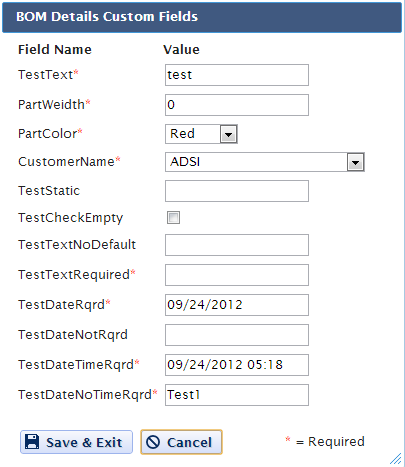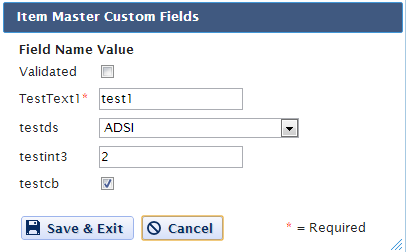| 1. Bill of Material |
| 1.1. Introduction |
|
ADDRESS {rootURL} orders
NOTE: {rootURL} is the URL you use to access web ManEx
AVAILABLE ACTIONS From this screen, the user can:
|
| 1.2. Fields and Definitions |
Bill of Material - Standard
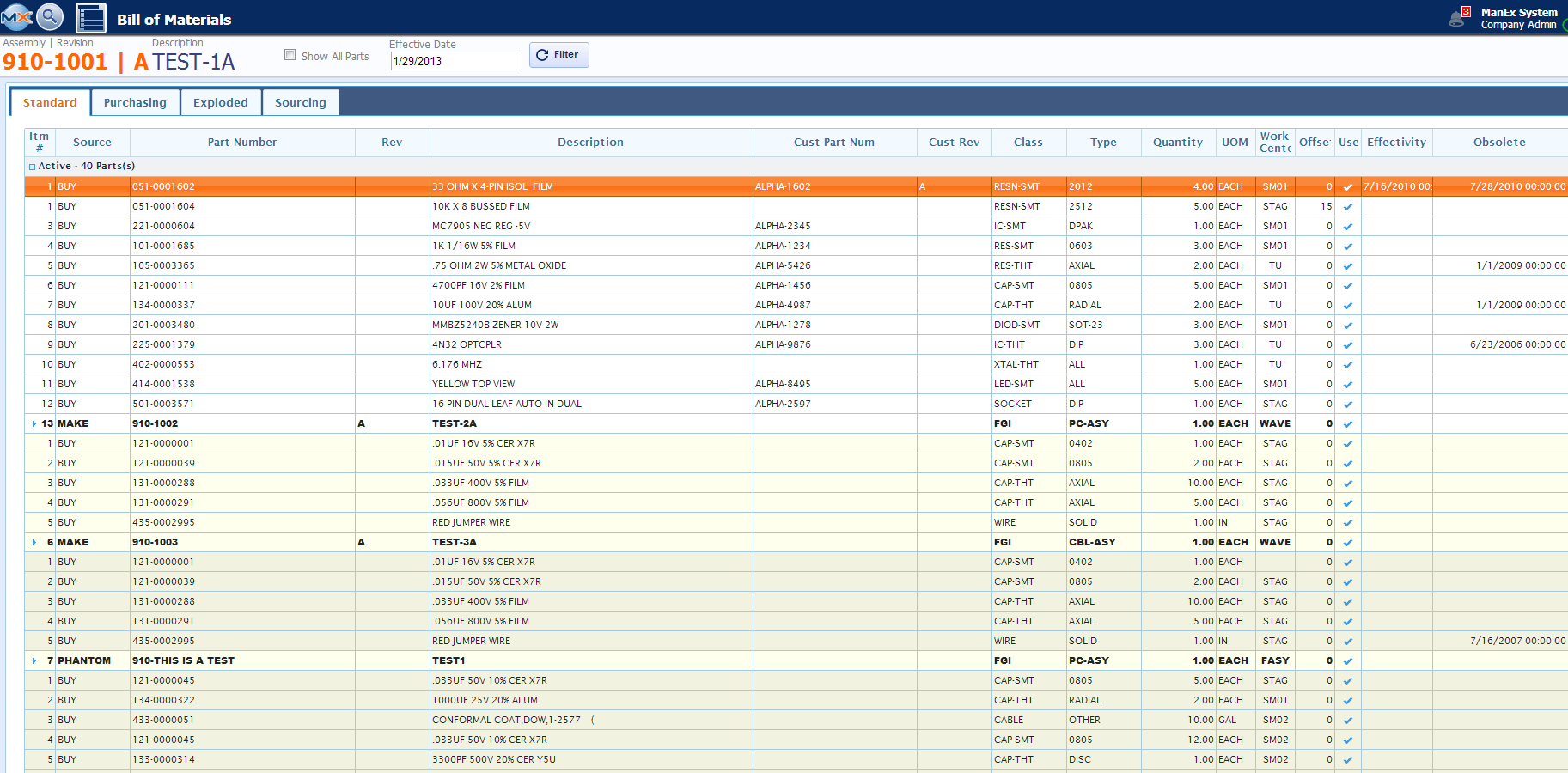 Itm# - The item number assigned to the components in the BOM.
Part Number - The components internal Manex part number
Rev - The Part Number Revision for the component. A component may exist under multiple revisions. Each Rev. is considered a unique part number and may co-exist with other Revs. or replace other Revs
Source - The sources of the assembly components. Select Make, Buy, Consigned or Phantom
Description - The Item Master description of the component part.
Cust Rev - The Part Number Revision for the component. A component may exist under multiple revisions. Each Rev. is considered a unique part number and may co-exist with other Revs. or replace other Revs
Class - The Part Class of the component part as assigned in the Item Master
Type - The Part Type of the component part as assigned in the Item Master
Quantity - The quantity of the component part used in the assembly. This qty does NOT compensate for setup and run losses; The Setup % and Run Qty fields in the Item Master screen cover production losses
UOM - The stocking/kitting unit of measure for the part
Work Center - The work center identified in the routing for the assembly at which the part is needed. Kitting of the part by work center will use this information to determine which parts are to be kitted for each work center
Offset - Production offset is a BoM item level field that allows users to control delivery dates in relation to the starting date of the work order. By using this field, the user may move the material requirement date by the specified number of days in either direction
Used - Identifies the part as requiring kitting from the storeroom. Typical Non-kitted items include chemicals and adhesives that are re-issued when they run low but are included on the BOM for costing or reference
Effectively - This is the date that the part is added and/or removed from the BOM and the demands will be displayed in MRP. MRP picks up all the records with an effective date earlier or equal to current date, and all NULL/BLANK effective dates
Obsolete - The date the part is no longer required on the BOM for new work orders and the demands will NOT be displayed in MRP
Bill of Material - Purchasing
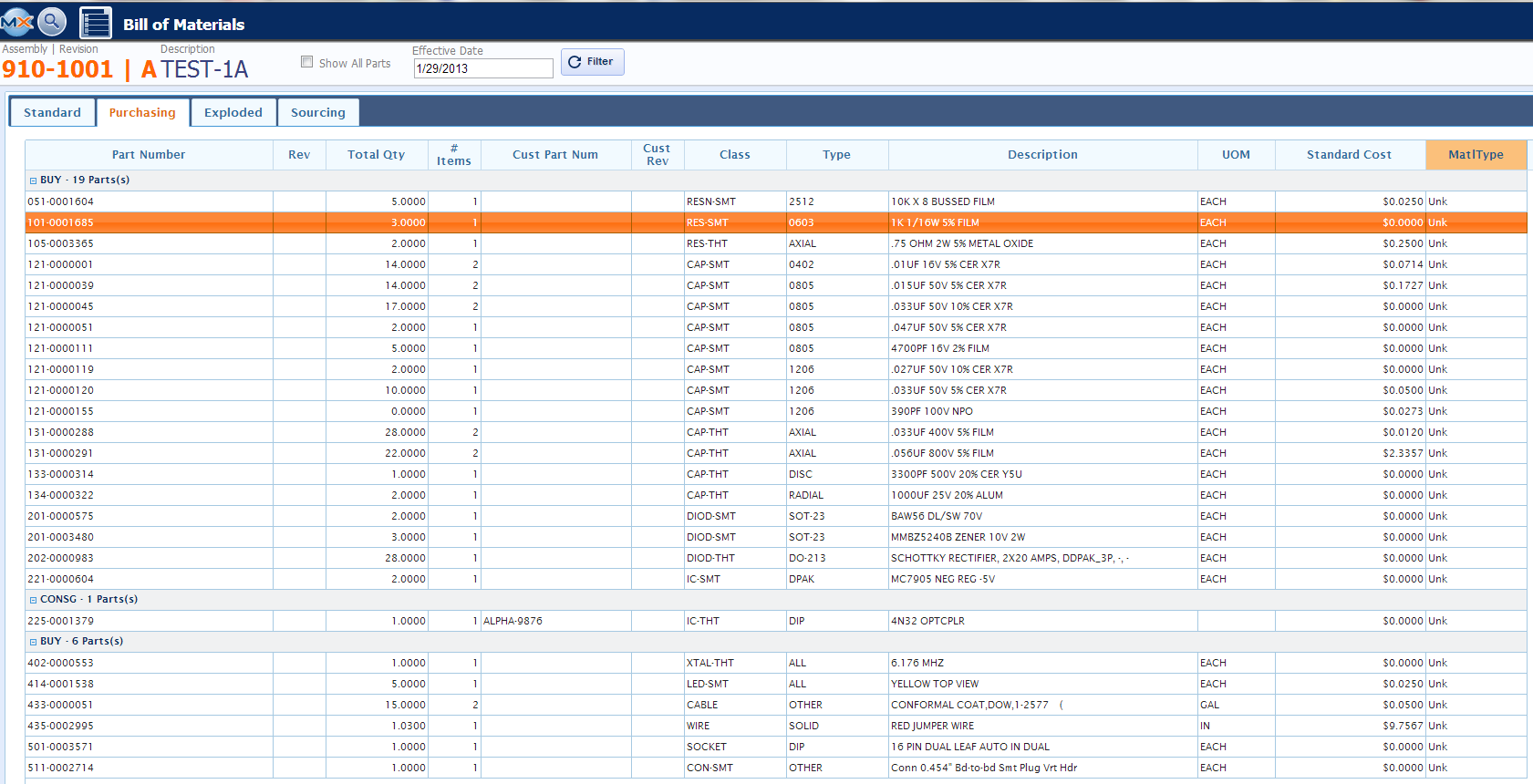 Part Number - The components internal Manex part number
Rev - The Part Number Revision for the component. A component may exist under multiple revisions. Each Rev. is considered a unique part number and may co-exist with other Revs. or replace other Revs
Total Qty - The quantity of the component part used in the assembly. This qty does NOT compensate for setup and run losses; The Setup % and Run Qty fields in the Item Master screen cover production losses
# Items - The item number assigned to the components in the BOM
Cust Part Num - The number the customer uses to identify the part.
Cust Rev - The Part Number Revision for the component. A component may exist under multiple revisions. Each Rev. is considered a unique part number and may co-exist with other Revs. or replace other Revs
Class - The Part Class of the component part as assigned in the Item Master
Type - The Part Type of the component part as assigned in the Item Master
Description - The Item Master description of the component part
UOM - The stocking/kitting unit of measure for the part
Standard Cost - The STANDARD COST of an item is a calculated value determined by the sum of individual costs. These individual costs may be in any combination of the Material, Labor, Overhead, Other and User Defined costs
MatlType - AVL Material Type Code. LF, LF-Date, LF-Mark, LF-P/N, RoHS, RoHS-Date, RoHS-Mark, RoHS-P/N, and Unk are the AVL Material types that are hard-coded into the system.
LF (Lead-Free), RoHS (the restriction of the use of certain hazardous substances in electrical and electronic equipment) or (In general, RoHS requirements include limitations on other heavy metals in addition to being lead free. But many companies may not meet the full requirements of RoHS, but still want to identify the material as Lead Free(, and Unk (Unknown) are the Inventory Material Types that are hard-coded into the system. Then sometimes the user wishes to identify a date code, marking or part number which designates that the part has switched from unknown to LF or RoHS, and that is what the additional modifier is for. Bill of Material - Exploded
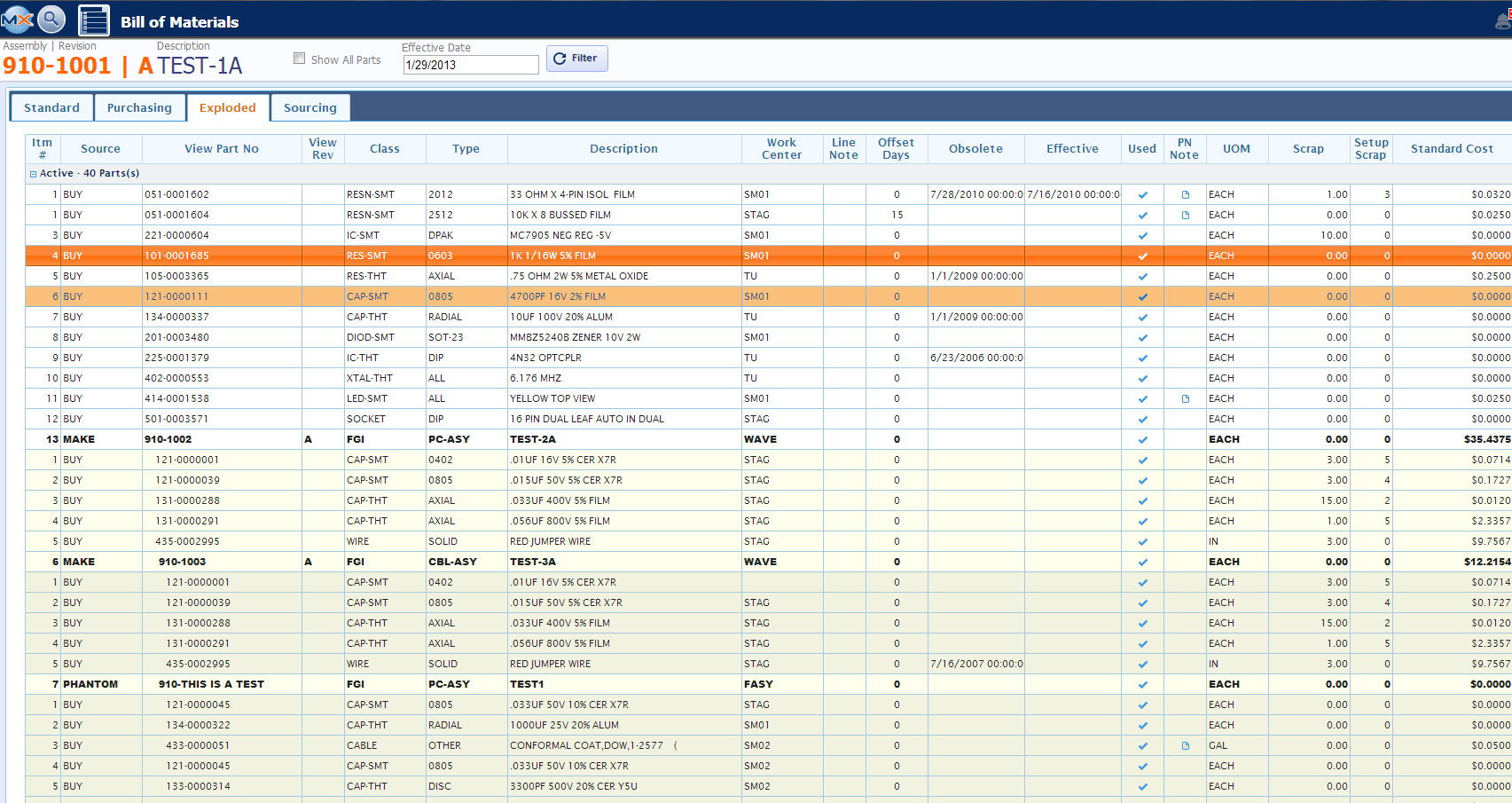 Itm # - The item numbers assigned to the components in the BOM
Source - The sources of the assembly components. Select Make, Buy, Consigned or Phantom
View Part No - The components internal Manex part number. Depressing this button will display BOM Details, Item Master Custom Fields, AVL Configurations, and Ref Designators for selected part
View Rev - The Part Number Revision for the component. A component may exist under multiple revisions. Each Rev. is considered a unique part number and may co-exist with other Revs. or replace other Revs
Class - The Part Class of the component part as assigned in the Item Master
Type - The Part Type of the component part as assigned in the Item Master
Description - The Item Master description of the component part
Work Center - The work center identified in the routing for the assembly at which the part is needed. Kitting of the part by work center will use this information to determine which parts are to be kitted for each work center
Line Note -
Offset Days - - Production offset is a BoM item level field that allows users to control delivery dates in relation to the starting date of the work order. By using this field, the user may move the material requirement date by the specified number of days in either direction
Obsolete - The date the part is no longer required on the BOM for new work orders and the demands will NOT be displayed in MRP
Effective - -This is the date that the part is added and/or removed from the BOM and the demands will be displayed in MRP. MRP picks up all the records with an effective date earlier or equal to current date, and all NULL/BLANK effective dates
Used - Identifies the part as requiring kitting from the storeroom. Typical Non-kitted items include chemicals and adhesives that are re-issued when they run low but are included on the BOM for costing or reference
PN Note - Depressing this button will display BOM Details, Item Master Custom Fields, AVL Configurations, and Ref Designators for selected part
UOM - The stocking/kitting unit of measure for the part.
Scrap - This amount is added to the exact quantity used on an assembly to provide an overage to cover losses during running due to predictable machine and human losses
Setup Scrap - Setup losses may be added to the BOM requirement and Run Scrap for an item.For instance, an auto-insertion machine may use extra parts for alignment checks
Standard Cost - The STANDARD COST of an item is a calculated value determined by the sum of individual costs. These individual costs may be in any combination of the Material, Labor, Overhead, Other and User Defined costs.
Bill of Material - Sourcing
 Source - The sources of the assembly components. Select Make, Buy, Consigned or Phantom
View Part No - The components internal Manex part number. Depressing this button will display BOM Details, Item Master Custom Fields, AVL Configurations, and Ref Designators for selected part
View Rev - The Part Number Revision for the component. A component may exist under multiple revisions. Each Rev. is considered a unique part number and may co-exist with other Revs. or replace other Revs
Class - The Part Class of the component part as assigned in the Item Master
Type - The Part Type of the component part as assigned in the Item Master
Description - The Item Master description of the component part
UOM - The stocking/kitting unit of measure for the part
Standard Cost - The STANDARD COST of an item is a calculated value determined by the sum of individual costs. These individual costs may be in any combination of the Material, Labor, Overhead, Other and User Defined costs.
Part Mfr - Is the name of the manufacturer of this part
MfrPartNo - Displays the Mfg. Part Number for an existing highlighted Mfg
Last Sup - Last Supplier used.
Most Sup - Supplier Most Used.
|
| 1.3. How To |
| 1.3.1. Find and View a Bill of Material | ||||
Login to the WebManEx and Select Product Data Management
Select the Bill of Materials Icon and the following find screen will be displayed:
Select Bill of Material from this screen and ALL then depress the "Go" button and a Listing of Part Numbers will be displayed:
 Double Click on a Part Number and the Bill of Material for this Part will be displayed. This screen will display all Active parts, Buy, Consigned, Make, and Phantoms.
User may drill down to see more detail per part by:
There are four tabs available. Each tab will display different information for the items listed in this Bill of Material.
The first tab is the Standard Tab - this tab will display all the active parts for this BOM, the Item #, Source, Part Number, Rev, Description, Cust Part Num, Reg, Class, Type, Qty per assembly, UOM, Work Centers, Offset days (if applicable), If used in kit, Effectively, and Obsolete Dates.  The second tab is the Purchasing Tab - this tab displays the Buy and Consgined parts listed on the BOM, Part Number, Total Qty per assembly, Item #, Customer Part Number (if applicable), Class, Type, Description, UOM, Standard Cost, and Matl Type.
 The third tab is the Exploded Tab - this tab will explode out any Sub Assemblies, Make or Phantom Assemblies listed on the original BOM, along with the Part Numbers, Class, Type, Description, Work Center, Line Notes, Offset Days, Obsolete and Effective dates, Used on BOM, PN Notes, UOM, Scrap and Setup Scrap and Standard Cost.
 The fourth tab is the Sourcing Tab - This tab will display the Buy and Consigned parts or parts that will be sourced out to Suppliers. This tab will list the Source, Part Number, Class, Type, Description, UOM, Standard Cost, Part Mfgr and Mfgr Part No, Last Supplier used and Supplier Most used.
 On any of the tabs if user want to view more detail for a specific part, such as the AVL information, or Reference Designators,or add any BOM or Item Master Detail:

All standard grid customizations apply. See related Article for more information. |
